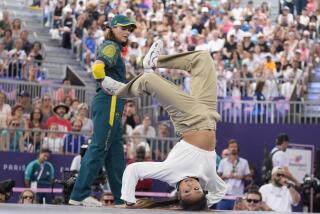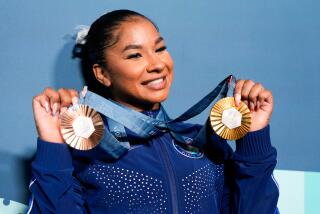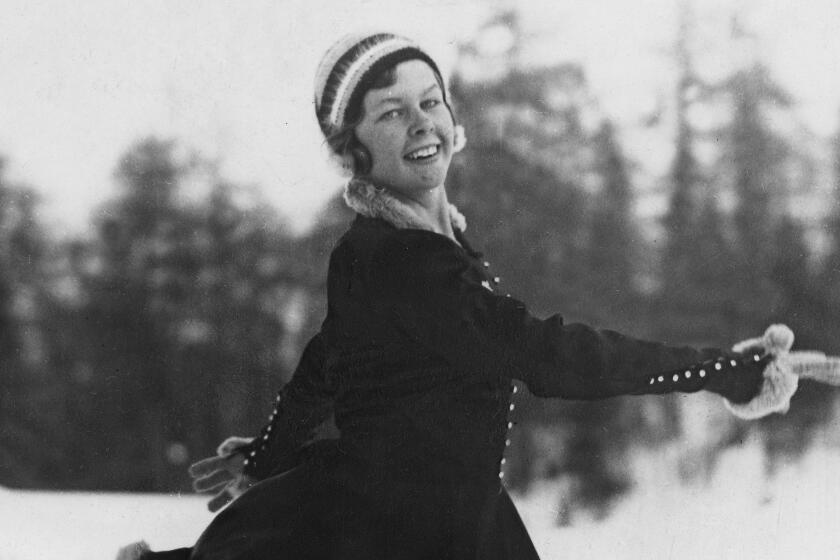U.S. OLYMPIC FESTIVAL : A Sport That Finally Turned the Tables : Table Tennis’ Olympic Approval Has Helped Two Players Overcome Identity Crisis
RALEIGH, N.C. — First comes the inquiring look.
Then the questions.
Always innocent.
Always wrong.
Carol Davidson of Studio City and Kim Gilbert of Van Nuys look like athletes. They dress like athletes--everything from warmup suits to sweat bands to workout bags.
So people, particularly here at the U.S. Olympic Festival, want to know.
Are you a volleyball player?
Which track and field event are you entered in?
You’re in softball, right? “A lot of people think I’m in judo,” Gilbert says. “I don’t know why judo.”
Finally, Gilbert or Davidson will tell them: I’m a table tennis player.
The reaction is universal--a blank stare, followed by an “Oh, you mean Ping-Pong?” followed by a description of some table the questioner played on in their backyard or garage.
Everybody, it seems, has played table tennis at one time or another. But very few, it seems, take it too seriously.
At least not in this country.
“I met a girl recently in L.A.,” Davidson says, “who recognized me. She wanted to see my paddle. I asked her how she knew I had one. Seems she was from Sweden, where table tennis is big. That’s the first time in my life I’ve ever experienced that, where someone knew who I was. It made me feel real good.”
Davidson knows it was probably a one-time incident. She’s not exactly sitting by the phone waiting for Johnny Carson to call.
“It’s like saving the whale,” says Bev Shaffer of Woodland Hills, the United States Olympic Committee liason to table tennis. “Somebody has to do something exciting to save this sport, or even to start it up.”
Somebody, namely the South Koreans, may just be about to do that thanks to that whale of a sporting event, the Olympic Games.
Table tennis will be an official sport in the 1988 Olympics in Seoul. And in South Korea, nobody says, “Oh,” at the mention of table tennis. It is big, perhaps second only to soccer among sports fans.
“This may be the best thing that ever happened to our sport,” says Sheila O’Dougherty, player representative for the United States Table Tennis Assn. of the ’88 Games. “In America, this may finally give us a chance to make a bona fide claim on some of the good athletes. Until now, we could offer nothing to hold them.”
At this point, it’s not an easy sport to embrace.
“On a good weekend,” Davidson says, “you could make maybe $50, $100, maybe even $300 by winning a tournament. But it costs money to travel to these events, to live. Even with your winnings, you come out on the minus side most of the time.”
This from someone who has been the U.S. national amateur champion the past two years.
Her success finally earned her a trip to Lake Placid, N.Y., several months ago to take part in a national training camp.
“For the first time,” the 28-year-old Davidson says, “I felt like a real athlete. I didn’t have the two big, real worries I usually have when I go on the road to play--finding some place to rest and sleep, and something to eat. They even actually gave me pocket money.”
The windfall profits from the 1984 Games in Los Angeles has provided funds for all Olympic sports, and that now includes table tennis.
That sport received $1.3 million, and USTTA officials are still formulating a policy that will provide some direction for spending the money. Some of it is already going for resident training programs at the U.S. Olympic headquarters in Colorado Springs.
For Davidson, the training began like it did for most of us, in her backyard. In her case, that was in her native Guyana, South America.
She left there 11 years ago to come to this country, but she never left the sport. She won the Carribean Championships when she was 15, just two years after taking up the game, and she was hooked.
But even Davidson, national champ though she may be, has to grab her practice sessions these days where she can. She plays at a club in Mar Vista, over in Malibu and in a friend’s basement, getting in three or four sessions a week when she can spare the time away from her marketing job.
Davidson thinks the problem could be solved with that $1.3 million in Olympic money.
“I don’t think that money is being used to the utmost,” she says. “I don’t think the USTTA is promoting the sport the way they ought to.
“They should make sure there are decent clubs where people can go and play. If there are no clubs, how do you expect us to go and practice? This is a big country. How do you expect the best players to get together? We also ought to play more outside of this country. The officials have their claws in the sport and trying to take it away from them would be like trying to take candy away from a baby.”
When Davidson’s remarks were relayed to them, USTTA officials insisted the resident training programs and a recent training program in China are good examples of what they see as a comprehensive new program.
Gilbert, 22, sees a more immediate solution.
Having just obtained the right to manufacture specialized Olympic jewelry, Gilbert wants to put some of the anticipated profits into forming a Los Angeles club in which players such as she and Davidson can hone their skills.
“It would not be open to the public,” Gilbert says. “If we do that, the quality will go down.”
Gilbert herself learned the game in a club. She didn’t start until age 14. Her father, Michael Horne, learned of the club from a business associate and put Gilbert in.
She certainly didn’t blow anybody away at first.
Just the opposite. “I was put in the lowest division,” she recalls, “and still everybody killed me for two years. That really hurts your ego.”
But she proved there is hope for us all. As long as your father is willing to send you to England to learn the game.
That is what happened to Gilbert at 17. She went to a coaching camp in England, then over to France for further instruction. She wound up being coached by Norisaku “Cannonball” Fuji, a world mixed doubles champion.
Her game accelerated rapidly. Only 17, she won a gold medal at the 1982 Festival.
Neither Davidson nor Gilbert are under any illusions about representing this country in Seoul. To say it will be a little difficult to make the Olympic table tennis team is kind of like saying Gerry Cooney could be expected to have a little trouble if he ever fought Mike Tyson.
In this first Olympic outing for table tennis, there will be only one squad for all of North America. Which figures to boil down to about two men and two women from the U.S., barely in the top 20 among national teams.
Davidson has won a bronze medal in the ’87 Olympic Festival, in Tuesday’s doubles event, marking the third straight year she has taken home a Festival medal.
Gilbert hasn’t won anything yet here, but she’s just happy to be playing.
She had major surgery a month ago to have a cyst removed and was advised by her doctor not to come to the Festival.
She probably should have listened, although her problems here have had nothing to do with the operation.
Gilbert has been seeing a chiropractor here for a stiff neck, had to withdraw from the women’s doubles Tuesday because of a sore shoulder, and had to default one match of the mixed doubles Monday because of a pulled leg muscle, although she was able to recover in that event and get to the bronze medal game with her partner, Lim Ming Chui of Bedford, Mass., before losing.
Gilbert once broke her hand, inadvertently smashing it against a table while playing.
None of it has discouraged her.
“Carol will be playing when she is 80,” Gilbert says of Davidson, “and I’ll be play until I’m 90.”
The injuries wouldn’t be so bad if at least people took her seriously.
“You know,” Gilbert says, “people are always surprised to hear you’re hurt. They don’t think you can get hurt in table tennis.”
Probably the same people who keep flashing that blank stare and asking, “You mean, ping pong?”
More to Read
Go beyond the scoreboard
Get the latest on L.A.'s teams in the daily Sports Report newsletter.
You may occasionally receive promotional content from the Los Angeles Times.






